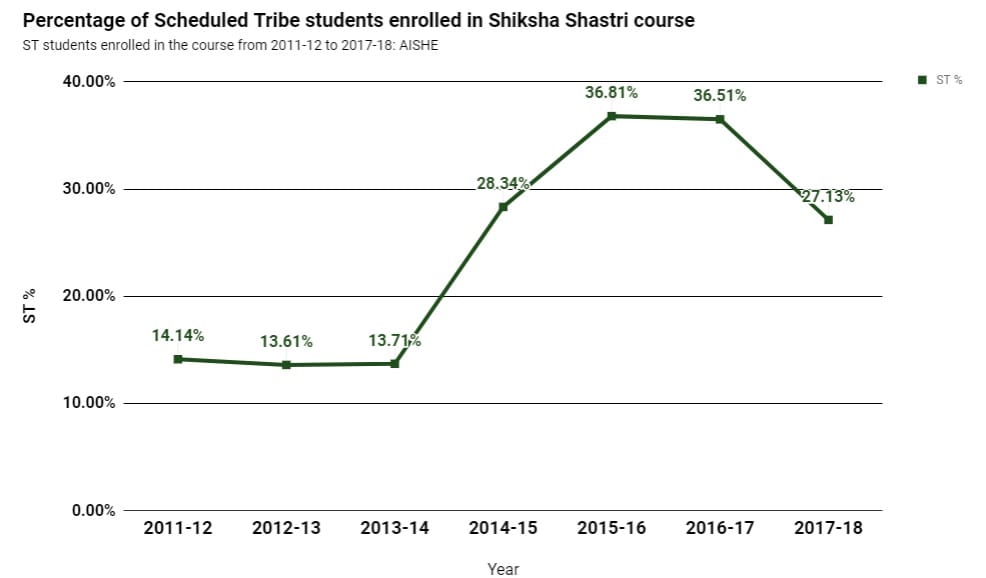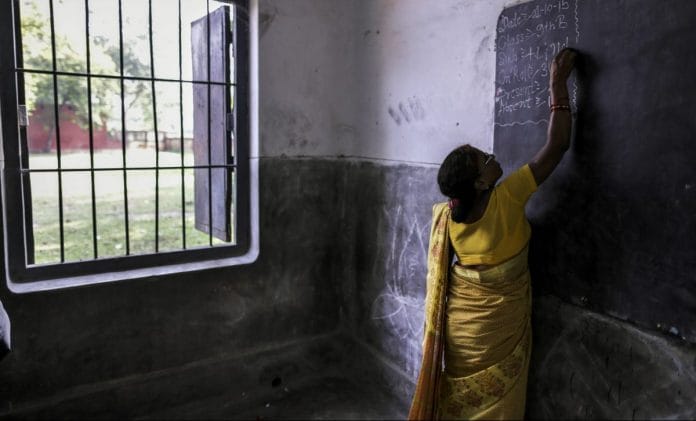7.5% of seats in the Shiksha Shastri course are reserved for STs, but they account for nearly 30% of all students in the course across India.
New Delhi: The number of Scheduled Tribe students signing up for Shiksha Shastri — a B.Ed. equivalent course in Sanskrit — has nearly doubled in the last six years, challenging the age-old Brahminical hegemony over the ancient language. And what’s more, they’re doing quite well at it.
According to data from the All India Survey on Higher Education, the ratio of ST students to the total number has gone up from 14.14 per cent in 2011-12 to 27.13 per cent in 2017-18. This is far more than the number of seats reserved for STs — 7.5 per cent.
 In fact, while 49.5 per cent of the total seats are reserved for SCs, STs and OBC candidates, the three groups together accounted for 72.27 per cent of all students in 2017-18.
In fact, while 49.5 per cent of the total seats are reserved for SCs, STs and OBC candidates, the three groups together accounted for 72.27 per cent of all students in 2017-18.
Not only are students from these ‘backward’ groups actually getting in on merit, faculty members say they’re performing better than the more ‘traditional’ students.
“Traditional students take up only Sanskrit after school, while more ‘modern’ ones take Sanskrit as main subject, but also add other subjects. Most students from the ST category belong to this ‘modern’ group, whose diverse knowledge helps them perform better,” said Vicharilal Meena, assistant professor at the Shri Lal Bahadur Shastri Rashtriya Sanskrit Vidyapeetha in New Delhi.
Also read: Muslims’ enrolment in higher education rises by 37%, gender parity also improves
Sentimental and practical factors
The reasons for this increase are actually a combination of sentimental and practical factors.
According to students at New Delhi’s Vidyapeetha, not only is this course a gateway to successful employment, it is relatively less expensive than the mainstream B.Ed. course. Faculty members told ThePrint that the fee for the Shiksha Shastri course is as low as Rs 5,000 per year, which is less than the fee for other B.Ed. courses.
“My friends suggested enrolling in Sanskrit studies after school, because they said the government provides support and financial aid, and there’s scope for employment in future. I completed the Shastri (equivalent to Bachelor’s) degree, and my teachers there inspired me to pursue the Shiksha Shastri course here,” said Tarun Kumar Singh, who hails from Bailama village of Sundargarh district in Odisha.
For others like Promila Naik from Odisha’s Keonjhar district, the more important factor is to preserve the heritage of Sanskrit as the mother of the Indo-European family of languages. An ‘Acharya’ (postgraduate) in the language, Naik says her college teachers inspired and motivated her to pursue her dream of teaching Sanskrit.
“I chose the Shiksha Shastri course because I want modern students to understand the ancient texts and scriptures. Sanskrit connects our roots,” she said.
According to Dr Devanand Shukla, deputy director of academics at New Delhi’s Rashtriya Sanskrit Sansthan, what has also increased demand is the government’s decision to make the degree compulsory for Sanskrit schoolteachers, and the higher number of seats due to increasing localisation of institutions. The Rashtriya Sanskrit Sansthan’s Puri campus, for example, is chock-full of students from the tribal areas of Odisha and Jharkhand.
 The course isn’t just a gateway to teaching; students learn rituals too, and can find employment as ‘Dharmagurus’ in various divisions of the Indian military, said Manoj Kumar Meena, assistant professor at the Vidyapeetha.
The course isn’t just a gateway to teaching; students learn rituals too, and can find employment as ‘Dharmagurus’ in various divisions of the Indian military, said Manoj Kumar Meena, assistant professor at the Vidyapeetha.
Rohini Bakshi, a London-based Sanskrit teacher who started the Twitter hashtag #SanskritAppreciationHour, said: “The world is getting more curious about Sanskrit, but due to strict migration policies, the outflow of Indian Sanskrit teachers isn’t very high. But technology has ensured that a lot of academic work is outsourced to them, which can supplement their incomes.”
Also read: Number of women enrolling in higher education rises 1,350 per cent in 7 years
Sociological factors
Sociologists and education experts agree that apart from economics, the promotion of the Sanskrit language by the government is behind this boost in Sanskrit education and the ‘backward’ groups studying it.
However, Janaki Rajan, professor at the department of teacher training and non-formal education at Delhi’s Jamia Millia Islamia said this high number of ST students could also be indicative of general category students pursuing more sought-after courses.
“If around 30 per cent of students are coming from the ST category, this could also mean that the proportion of general categories applying for this course might be low, because most general category students opt for and get absorbed in courses like science, math and the social sciences,” she said.
However, she agreed that economics were probably at the heart of this trend.
“Tribal students want to move to cities and improve their quality of life. Sanskrit is an easy and a scoring subject and B.Ed. in any subject is pathway to becoming a government teacher. Given the fact that the government is promoting Sanskrit, it becomes an attractive and achievable opportunity.”
Meanwhile, Rakesh Thakur, a Chandigarh-based associate professor of sociology, said this trend could also be seen as a purely linguistic phenomenon.
“India’s tribal population has carried its language in oral form for generations, and now it yearns for a written script. Sanskrit and its script, Devanagari, is the oldest form of language in the subcontinent. Perhaps that’s why tribal people’s search for a script is leading them to Sanskrit — it’s a connection to the past while also being a platform on which they can develop a base for their own language,” he said.







Thanks for sharing this nice post, if anyone wants to know more about one of the most divine languages of the world “Sanskrit”, then a well experienced Sanskrit Home Tutor will surely help you to increase your knowledge about Sanskrit. For more details, you can also visit: http://www.hindisanskrittutor.in/